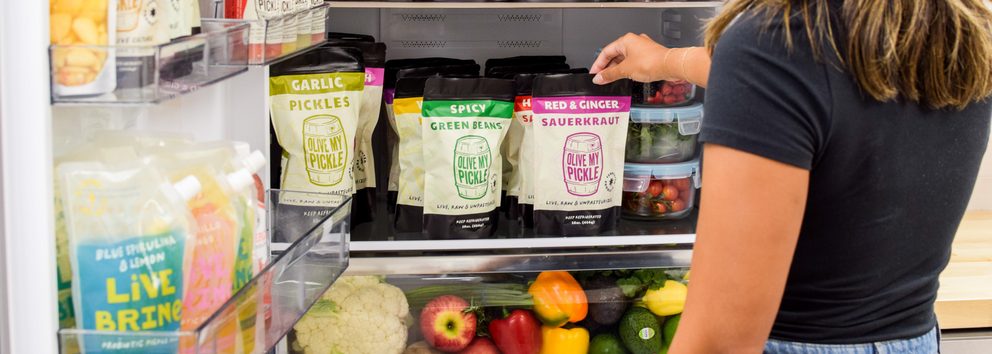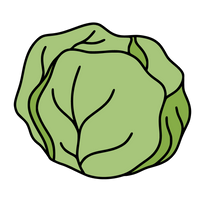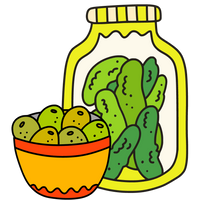
Fermented foods are alive. That's why we want to eat them, right? And it's because they're alive that they demonstrate lively behaviors and personality. Fermented foods have plenty going on under those surface appearances that might surprise even the most seasoned consumer and pickle enthusiast alike!
These signs are often misunderstood and seen as defects with the product. Quite the contrary, these are normal, predictable signs of life, indications that something has gone right with the ferment. But they can certainly catch you off guard if you're new to fermented foods.
We're here to break it down for you and let you in on what's normal and to be expected with live culture foods and the main things you need to know to best take care of your fermented food products.
By the end of this article, you'll be a pro! Let's get started.

Fermented Food Storage 101
Taking care of your fermented foods ensures they stay fresh and full of probiotics. We get a few questions about storing your them – here’s what you need to know to keep your ferments at their best.
Do fermented foods need to be refrigerated?
Fermented foods occupy a fascinating middle ground between shelf stable goods and items that must stay refrigerated. So it makes sense to ask if fermented foods should be stored in refrigeration.
The answer is yes, your fermented foods are happiest in the fridge. The first thing you'll want to do when your Olive My Pickle products arrive is to get them in the fridge.
Although fermented foods can hang outside of refrigeration for a good number of days, which is what allows us to ship them nationwide, the fermentation process may resume if left out for too long. Placing them in the fridge upon arrival will halt any fermentation that may have resumed in transit.
FUN FACT
Lactic acid bacteria will remain live in temperatures ranging from below freezing up to 143 degrees F. In fact, the temperature to pasteurize a food is 144 degrees F, which kills bacteria.
For temperature context, lukewarm is about 95 degrees F and a hot bowl of soup is around 180 degrees F.
Learn more about the safety of eating fermented foods, in our blog post: Are Fermented Foods Safe?

How long does fermented food last?
The shelf life of fermented foods is naturally pretty long since the veggies are preserved in salt water brine.
Here at Olive My Pickle, we mark our products with an expiration date 6 months from the time of packaging, which is plenty of time to enjoy the ferments!
Our advice is that fresh is best! Whether opened or unopened, they will be best if consumed within 3-6 months. As long as all your veggies are submerged under the level of the brine, they will keep just fine...which leads us to our next point.
Can your freeze sauerkraut or any OMP products?
The answer is no. We do not recommend freezing our products, because doing so will alter the consistency of the veggies. Say no to soggy sauerkraut or kimchi. You want it to stay fresh and crisp.
The exception is LiveBrine pickle juice, which freezes just fine. You can make LiveBrine ice cubes for your mocktails and cocktails or a hydrating glass of water.
 3 Simple Tips to Keep Your Ferments Fresh
3 Simple Tips to Keep Your Ferments Fresh
Fermented foods are naturally preserved, but a little extra care goes a long way in maintaining their flavor and probiotic benefits. Here are the most important things you need to know to ensure your fermented foods stay fresh and delicious.
1. Keep your ferments submerged under the brine
The best way to prevent kahm yeast from forming is to make sure your fermented foods are covered with brine (the salty water they're fermented in).
So when you put your products back in the fridge, squeeze the air out of the package, seal tightly, and give it a little squeeze so that everything is under the brine.
2. Always use clean utensils
Whenever you go to grab a spoonful of your kimchi or sauerkraut, make sure you use a clean utensil. Not only will this help to prevent bacterial contamination, but it will also prolong the shelf life of your fermented foods. After all, you don't want those beneficial probiotics going to waste!
So next time you reach for a forkful of fermented goodness, make sure it's clean and you'll be able to enjoy all the gut health benefits of your ferments for many months.

3. Don't let your fermented foods sit out for a long period of time
Yes, fermented foods are just fine to be outside of refrigeration for a bit, but if you want to prolong the life of your products it's best to keep the temperature fluctuations to a minimum.
Taking these steps will extend the shelf life of your fermented foods and reduce the chances that they will develop kahm yeast.

A Few Examples of Fermented Foods Behavior
Fermented foods can have a mind of their own, displaying natural changes that might seem unexpected. From harmless yeast and cloudy brine to puffy packaging, there are all normal signs of active fermentation.
Kahm Yeast
One of the fermented food behaviors that might surprise you is kahm yeast, which can form when oxygen is exposed to ferments.
- Kahm yeast is a surface-dwelling yeast and is common in water-based ferments like kombucha, beet kvass, olives and cucumber pickles. It's also known to show up on the top of fermented milk products like kefir and yogurt.
- It's 100% harmless. It's a sign that your ferment is indeed a live culture product: it's simply a sign of life.
- It looks like a thin, white film on the surface of your fermented food. It's often mistaken for mold, but it's harmless. One day, you might go to the fridge to grab a pickle and be shocked to find that they are covered in a white, chalky film. But don't be alarmed!
What to do if you find kahm yeast in your fermented foods? Just skim it off the top or rinse off your veggies and continue to enjoy your fermented food as usual!
How to tell if it's kahm yeast or mold? Mold is an extremely rare occurrence in fermented foods. Most of the time, when people are concerned about mold, it's actually kahm yeast. That said, use common sense and listen to your gut when you have ferments that may be presenting mold, and throw them out if you are concerned.
The main visual difference when mold is present is that it will appear fuzzy and sometimes may be a different color, such as blue or green. While kahm yeast looks like a white film.
A few reasons why mold may appear: exposure to oxygen, temperature fluctuations after the package is opened and placed on the counter, or dirty hands or utensils introducing mold pathogens. Again, it's pretty rare but mold can happen because mold happens.
Cloudy Brine
If you're new to naturally fermented foods for gut health, it may come as a surprise to see pickles floating around in some murky brine. Why does it look cloudy and milky like that? The answer is simple: because it's a true fermented product!
Many fermented foods are made by allowing beneficial bacteria to grow in the food, which helps to preserve it and gives it a unique, tangy flavor. The mark of a true fermented product is cloudy brine, so don't be alarmed if you see pickles that look a different than what you're expecting.
Sometimes the cloudiness settles to the bottom, so you can gently shake your package to redistribute before you open. In any case, cloudy brine is a good sign that you're getting a delicious, healthy fermented food!
 Puffy Pouches
Puffy Pouches
Puffiness is another normal occurrence within a sealed fermented foods product.
Because fermented foods are alive and active, they create gas which needs to be released. You can help your ferment by opening it up a bit and releasing the gas. Gas has to go somewhere (we can all relate to that.) If you don't release the gas, the package will eventually burst and leak.
If you haven't seen our unboxing video yet, be sure to check it out so you know exactly What to Expect When You Open Your Box.
Still not sure? Give us a shout!
Our Customer Happiness team is here for you and happy to chat about any questions you have about alive, fermented foods. Lively activity and behaviors, health benefits and other benefits of fermented foods: bring us your questions!
People also ask these questions. Here's a little resource guide:
What are the health benefits of fermented foods?
Fermented foods are beneficial for gut health due to the presence of probiotics, which are live microorganisms that can provide health benefits when consumed.
Probiotics are believed (and are being studied more and more these days) to help maintain a healthy balance of gut bacteria. Fermented foods are a rich source of these beneficial microorganisms and a delicious way to add beneficial lactic acid bacteria to your eating habits and support your overall health.
We take a deep dive into these health benefits in this blog post on the top 7 health benefits of fermented foods you need to know.
What's the big deal about lactic acid bacteria anyway?
Lactic acid bacteria are the type of probiotic that is found in fermented foods. Probiotics' official definition is a live bacterial organism that confers a health benefit to its host. These beneficial microorganisms help to maintain a healthy balance of gut bacteria.
What are the key benefits of fermented foods?
You may be wondering why you should eat fermented foods. There are many benefits of fermented foods, including improved gut health, immunity, mental clarity, digestion, and a high rate of nutrient absorption.
Examples of Fermented Foods for Gut Health
Some examples fermented foods include minimally processed, full fat yogurt, kimchi, miso, fermented sauerkraut, fermented pickles, fermented olives, and fermented vegetables.
Looking to add biodiversity to your microbiome by eating other fermented foods? Click here to learn more about the many fermented foods with probiotics.
Ready to Build Your Box?
Fermented foods are packed with probiotics, which are great for your gut health! So go ahead and enjoy your fermented foods, kahm yeast and all and build your box today! Cheers to a happy gut!
DISCLAIMER: THIS WEBSITE DOES NOT PROVIDE MEDICAL ADVICE
The content on this website is for informational or educational purposes only and does not substitute professional medical advice or consultations with healthcare professionals. Always seek the advice of your physician or other qualified healthcare provider(s) with any questions you have regarding a medical condition or treatment and before undertaking a new health care regimen.









